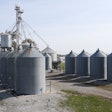The U.S. Department of Labor’s Occupational Safety and Health Administration (OSHA) and the National Grain and Feed Association (NGFA) have formed an alliance that will allow the grain, feed and processing industry to work more closely and collaboratively with the regulatory agency.
The alliance, signed by Deputy Assistant Secretary and Acting Assistant Secretary of OSHA Loren Sweatt and NGFA President Randy Gordon, during NGFA’s board of directors meeting in Washington, D.C., on September 13, provides NGFA members and others with information, guidance and access to resources that help to protect the safety of workers.
“I know you all are committed to safety and health,” Sweatt said before the NGFA board of directors at the signing. “And I know that this is a message you are committed to and will carry back home.”
This collaboration – which lasts for two years – is designed to help NGFA build trusting, cooperative relationships with the agency; network with OSHA staff to increase lines of communication within the agency; leverage resources to maximize worker safety and health protection; and gain recognition as a proactive leader in safety and health.
There are few formal program requirements for alliances, and the agreements do not include a standards or enforcement component. However, OSHA and the participating organizations must define, implement and meet a set of short and long-term goals that fall into two categories: 1) raising awareness of OSHA’s rulemaking and enforcement initiatives and 2) outreach and communication.
Acting Deputy Assistant Secretary Tom Galassi has described alliance between the NGFA and OSHA as “the first step in a process where we work together to allow you to understand OSHA and us you.”
Through the alliance, the NGFA and OSHA will focus on providing NGFA members and OSHA staff with information guidance and access to resources regarding the safety and health hazards associated with grain bin entry, machine guarding, respiratory protection, falls, heat, combustible dust, struck-by and lockout/tagout. The sharing of information can be done through promoting participation in OSHA’s cooperative programs; and speaking or exhibiting at conferences and meetings.
Greg Rowe, vice president of grain and processing operations at Perdue Agribusiness, Salisbury, Maryland, and chair of NGFA’s Safety, Health and Environmental Quality Committee, said the alliance will provide more a proactive and structured process with the agency and will allow NGFA members to more frequently meet “face to face with OSHA on a more regular basis.”
An implementation team consisting of representatives from each organization will meet to develop a work plan, determine working procedures, and identify the roles and responsibilities of the participants. NGFA’s team will include staff and members of the Safety, Health and Environmental Quality committee. OSHA’s team will consist of staff from the Directorate of Cooperative and State Programs, Directorate of Enforcement Programs, Directorate of Standards and Guidance and selected regions, including 5, 6, 7, 8 and 10. The American Feed Industry Association and the Grain Elevator Processing Society also will be invited to participate on the implementation team as guests.
Kim Stille, the OSHA Region VII administrator, said the alliance provides an opportunity for the agency and the industry to learn from each other. By focusing on significant hazards faced in five OSHA regions, Stille said the alliance will help OSHA “work in a collaborative fashion … with the industry to identify the hazards and communicate them to a wider audience” than we could with inspections.

















